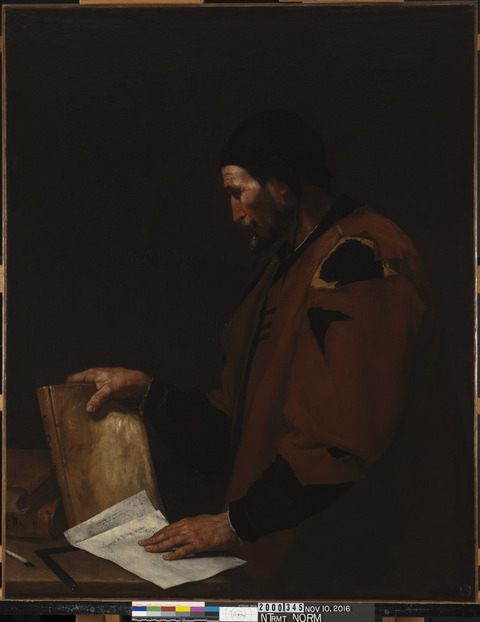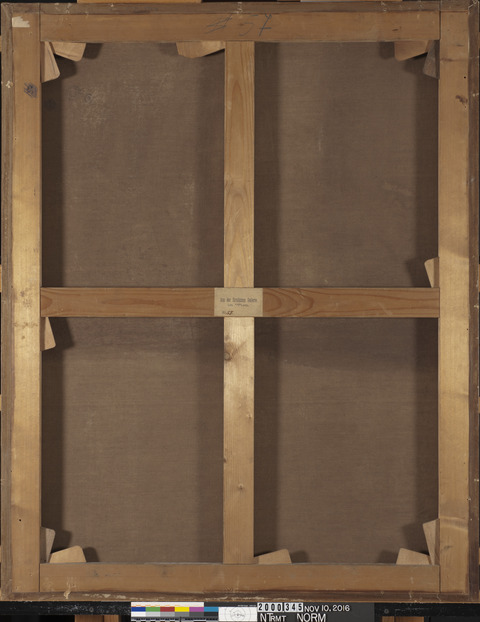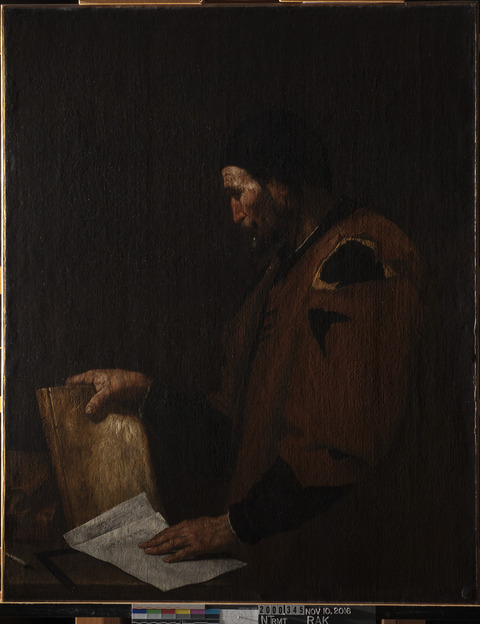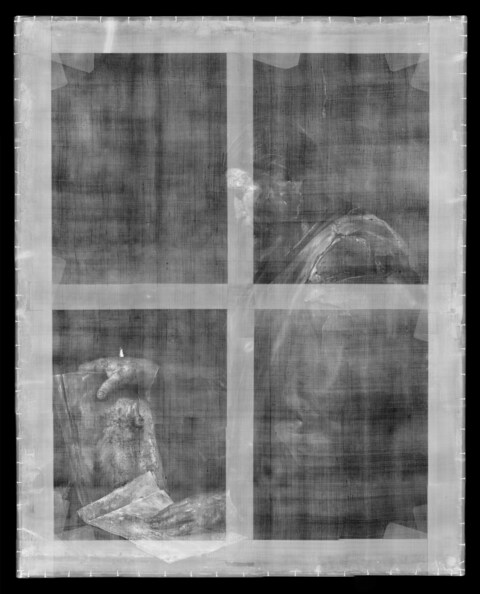Overview:
Identification number: 2000.345
Artist: Jusepe de Ribera (signed)
Title: A Philosopher, probably Euclid
Materials: Oil (untested) on canvas
Date of creation: 1637
Previous number/accession number: C10066
Dimensions:
124.7 × 98.7 cm
Conservator/examiner: Roxane Sperber with contributions from Erica Schuler
Examination completed: 2018
Distinguishing Marks:
Front:
Item 1. Signature in black paint: “Jusepe de Ribera espaῆol/F.1637” (tech. figs. 1, 2).
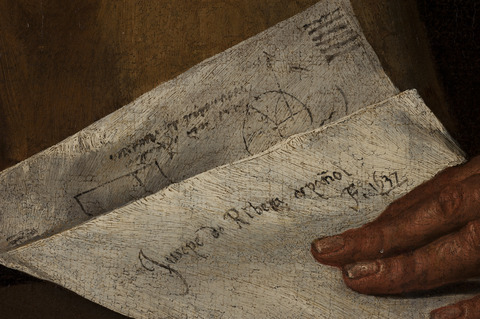
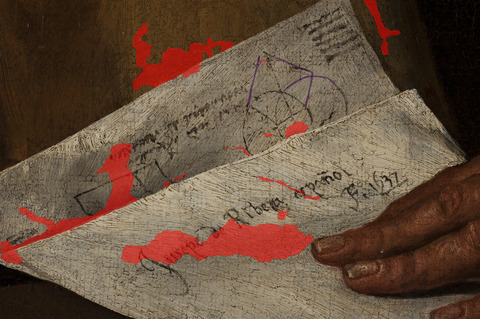

Item 2. low relief seal in the lower-right corner of the painting (tech. figs. 3–6).
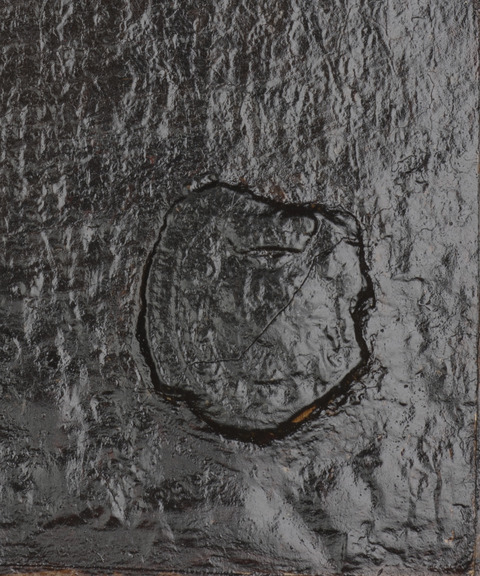
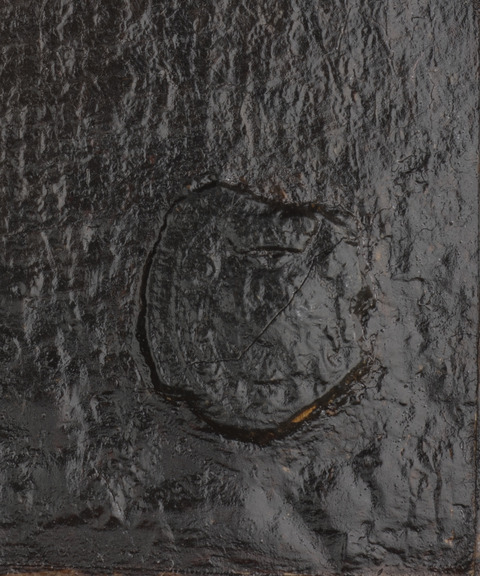
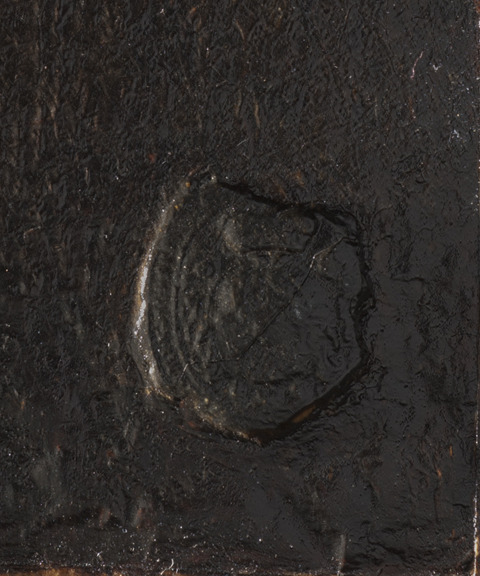
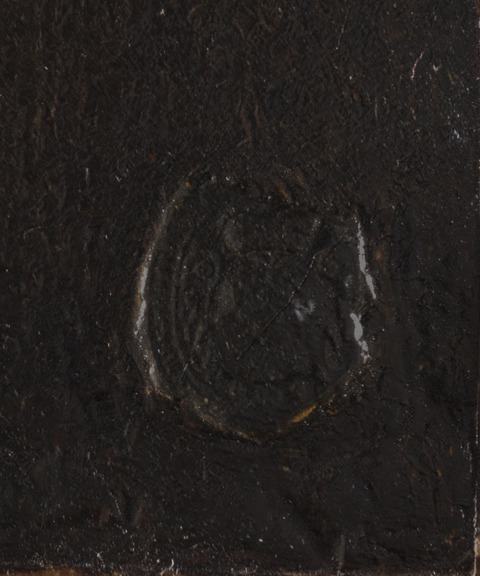
Back:
Item 3. Four circular stamps, stamped onto the back, upper-left corner (canvas and stretcher), infrared-transparent black ink (tech. fig. 7).
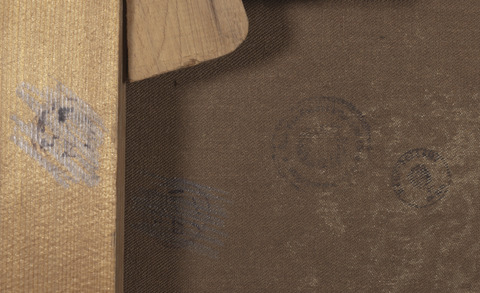
Item 4. Off-white paper label adhered at intersection of the stretcher’s cross bars; contains both printed and handwritten text: “Aus der fürstlichen Gallerie / in Wien. / No57” (tech. fig. 8).
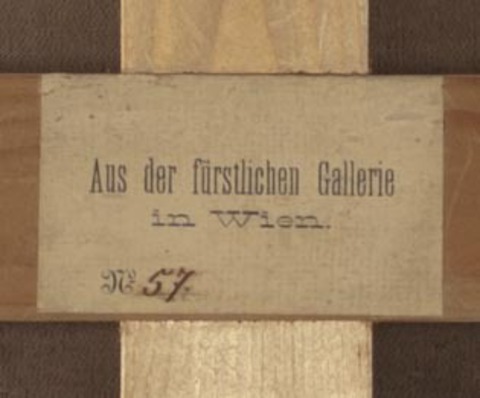
Item 5. Handwritten graphite inscription, crossed out in blue marker, is present at the center of the top stretcher member (back): “11”; handwritten inscription in blue marker, center of top stretcher member: “57” (tech. fig. 9).
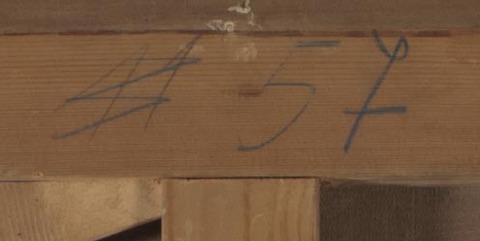
Item 6. Handwritten graphite inscription on back, top-left edge: “15636 / 49 × 39” (tech. fig. 10).

Summary of Treatment History
Evidence of extensive past interventions to correct structural and aesthetic issues are present on the painting. They include the application of a glue-paste lining, tear repair, varnish removal, retouching, and the application of a new varnish layer. There are also several documented reports of the painting’s condition and treatment.
In a letter from Bert Newhouse to Dr. Clowes, dated 13 December 1955, Newhouse responded to an inquiry by Clowes about the dark appearance of the background of the painting, stating that “the picture was cleaned some short while ago by the man who does the conservation work for the paintings in the Liechtenstein Collection. When we had the picture here at the Galleries, we looked at it very carefully and, while we felt that there might be some slight improvement in recleaning the picture, we felt that the enhancement would be so slight, if at all, that we did not feel that it was necessary. The man who did this work is considered to be one of the outstanding conservators and restorers of Europe. He has a reputation of undercleaning rather than overcleaning, and I believe that certainly this is the wise and better procedure than attempting to go too far with the painting."1
In 1968, Mark Roskill examined the painting and described the condition of the work as good. “The character of the sleeve suggests some repainting in that area."2 Documentation suggests a series of condition assessments and treatments were carried out on the collection around the time the works were moved from the Clowes residence to the IMA in 1971. A condition report by Paul Spheeris in October of that year, likely carried out before the paintings were relocated, described the painting as “O.K.” He recommended the painting be cleaned for the sake of its appearance.3 A second condition assessment was carried out upon arrival of the paintings at the IMA. This assessment described the work as being in good condition, and no work was deemed necessary.4
A memorandum from 1996 summarizing treatment and examination of the Clowes Collection from the time it entered the collection suggested that a minor treatment was carried out in August 1992 by David Miller in order to prepare the work for loan.5 Treatment included consolidation of lifting cracks associated with old fills, dry cleaning to lightly dust the surface, light aqueous surface cleaning to remove loose grime, thin varnish application to saturate depth and detail throughout, and finally inpainting to reduce the visibility of old and poorly matched retouching made visible by the saturating varnish.6
In April 2003, treatment was undertaken to reform varnish at the site of a scratch running through the hand holding the book. An image was taken prior to treatment showing the scratch visible beneath the hand and extending into the figure’s coat. The treatment report states that “the paint was not harmed…the scratch is only in the uppermost thin layer of varnish, identified as Dammar in the treatment report dated 8/31/92.” Reforming the varnish was achieved by applying isopropanol with a #00 brush only to the damage itself.7
Current Condition Summary
The painting is in fair and stable condition. Multiple past interventions have addressed both structural and aesthetic issues. The original canvas support is glue-paste lined, and the painting is tensioned on an adjustable wood stretcher. The edges are covered with brown paper tape. The ground and paint layers are in fair condition. Fills along the edges of the canvas extend the original paint layer to the size of the new stretcher. Numerous losses are present along the edges as well as ones associated with losses to the canvas support. There are several layers of varnish and retouching across the canvas. Extensive retouching is present along the edges of the painting where the canvas has been enlarged during the lining process. There is also extensive retouching throughout the background and associated with losses to the canvas.
Methods of Examination, Imaging, and Analysis
| Examination/Imaging | Analysis (no sample required) | Analysis (sample required) |
|---|---|---|
| Unaided eye | Dendrochronology | Microchemical analysis |
| Optical microscopy | Wood identification | Fiber ID |
| Incident light | Microchemical analysis | Cross-section sampling |
| Raking light | Thread count analysis | Dispersed pigment sample |
| Reflected/specular light | X-ray fluorescence spectroscopy (XRF) | Fourier-transform infrared spectroscopy (FTIR) |
| Transmitted light | Macro X-ray fluorescence scanning (MA-XRF) | Raman microspectroscopy |
| Ultraviolet-induced visible fluorescence (UV) | ||
| Infrared reflectography (IRR) | Gas chromatography–mass spectrometry (GC-MS) | |
| Infrared transmittography (IRT) | Scanning electron microscope -energy dispersive X-ray spectroscopy (SEM-EDS) | |
| Infrared luminescence | Other: | |
| X-radiography |
Technical Examination
Description of Support
Analyzed Observed
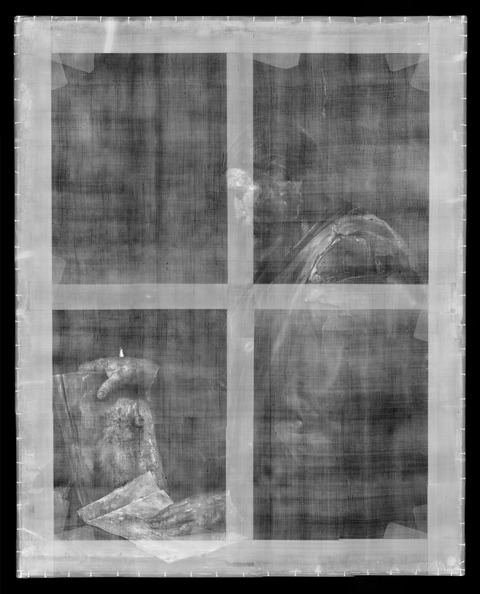
Material (fabric, wood, metal, dendrochronology results, fiber ID information, etc.):
The painting is executed on a plain-weave fabric support with an open weave (tech. fig. 11). The warp and weft are generally uniform in size/thickness, spacing, and count. The thread count was determined to be 17 yarns per inch in the vertical direction by 16 yarns per inch in the horizontal direction (tech. fig. 12). The weave direction cannot be discerned as no tacking margins have been retained, and no selvage edge is identifiable.
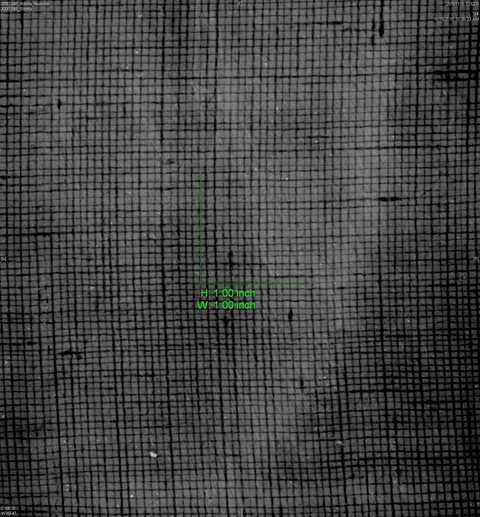
The painting is lined with a tightly woven plain-weave canvas. The lining appears to be a glue-paste lining. The lining canvas has dark stains on the back that may be from the lining adhesive or possible varnish that has passed through to the back of the canvas. The back does have some patches that luminesce in ultraviolet-induced visible fluorescence, however the dark stains do not correspond to the fluorescence (tech. fig. 13).
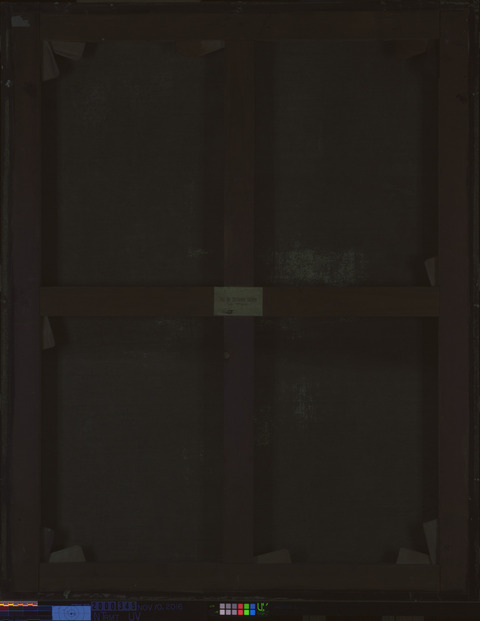
Characteristics of Construction / Fabrication (cusping, beveled edges of panels, seams, joins, battens):
The original support is composed of a single piece of canvas. Cusping is present along the right and left edges of the canvas, suggesting the width was not reduced. The dimensions of the original canvas are nearly identical to those in a record of the Count of Lichtenstein’s collection from 1767 (see table 1).8 These dimensions are also similar to other works in this series, including Protagoras, now in the Wadsworth Atheneum Museum of Art;9 A Philosopher, now at the Los Angeles County Museum of Art;10 and Democritus, now in the Museo del Prado.11 The canvas of the Clowes painting appears to have been extended by several centimeters when lined onto the current stretcher. The edges of the original canvas can be observed in raking light. The painted extensions may have been intended to square up the composition. This suggests that the original tacking margins were completely removed rather than flattened to extend the image.
| Year | Height (ft) | Height (cm) | Width (ft) | Width (cm) |
|---|---|---|---|---|
| 1767 dimensions | 3 ft 11-1/2 in. (47-1/2 in.) | 120.65 cm | 3 ft. 1-1/2 in. (37-1/2 in.) | 95.25 cm |
Current dimensions (original canvas) | 4 ft. (48 in.) | 122 cm | 3 ft. 1-1/2 in. (37-1/2 in.) | 95.25 cm |
Current dimensions (current stretcher) | 4 ft. 1-1/16 in. (49-1/16 in) | 124.7 cm | 3 ft. 2-7/8 in (38-7/8 in.) | 98.7 cm |
Table 1: Dimensions of the painting
Thickness (for panels or boards):
N/A
Production/Dealer’s marks:
No mark visible on original support. Stamp on lining canvas (see Distinguishing marks)
Auxiliary Support:
Original Not original Not able to discern None
The auxiliary support is a nonoriginal six-member stretcher with bridal joints. The horizontal cross bar is a single member with mortise and tenon joints on either side attaching it to the left and right stretcher bars. The vertical crossbar is composed of two members. The corner joins are mortise and tenon joints. The stretcher has 12 of 12 stretcher keys. The stretcher is not original to the painting and likely dates to the twentieth century.
Attachment to Auxiliary Support:
The edges of the canvas are covered in brown paper tape making it impossible to see the head of the nails that hold the canvas to the support. However, metal cut nails are visible in the X-radiograph (tech. fig. 11). These nails are regular in size and shape, suggesting they date to after 1890.12
Condition of Support
There are several tears and losses to the original canvas that may have prompted the painting to be lined. The tacking margins of the original canvas have been removed, likely when the painting was lined. Frayed edges of the canvas can be seen in the X-radiograph (tech. fig. 11). There is a damage that appears to be a large linear tear above the head of the man to the right of his hat. Several threads along this linear damage appear to have been severed, although most of the threads appear intact. It may be that the loss was primarily to the ground and paint layer. There is another C-shaped damage that cuts through the figure’s ear and neck that is similar in appearance in the X-radiograph. There are several threads that have been severed, but the loss is primarily to the ground and paint layer. It is possible that the threads of the tear were carefully joined before the painting was lined, but if this was the case it was done with extreme care. There is a complete loss to the canvas above the figure’s proper right hand.
The lining canvas is in good condition. The canvas is still flexible and not very degraded. This appearance, in conjunction with the apparent age of the stretcher, suggests the lining was performed sometime in the twentieth century before the painting came into the IMA collection. Given the age of the painting, it may have had a previous lining before the current lining was applied. There are no losses to the lining canvas, the tension is good, and the canvas is in plane.
Description of Ground
Analyzed Observed
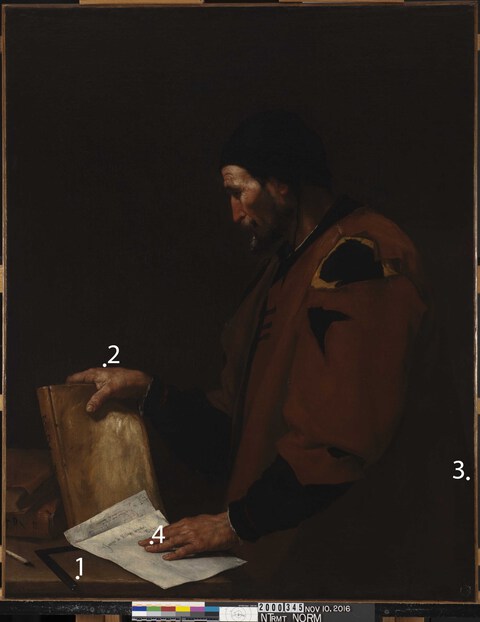
Materials/Binding Medium:
Cross section 3 from the background shows the ground layer of the painting (for sample location see tech. fig. 14). The ground layer is a reddish-brown layer that has been thickly applied across the canvas (tech. fig. 15, layer 2).
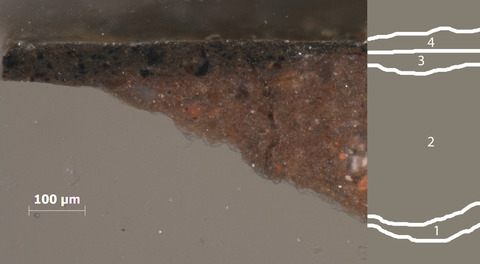
The ground is largely composed of a mixture of aluminosilicates, with the addition of pyrite, dolomite, calcite, and other minerals (tech. figs. 16–18).
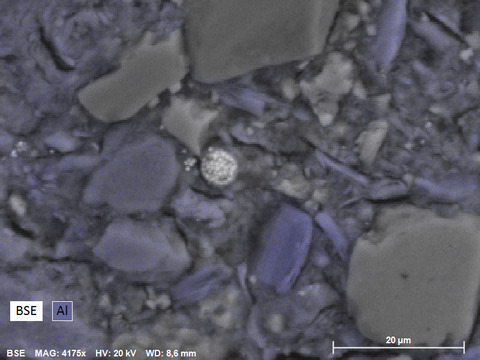
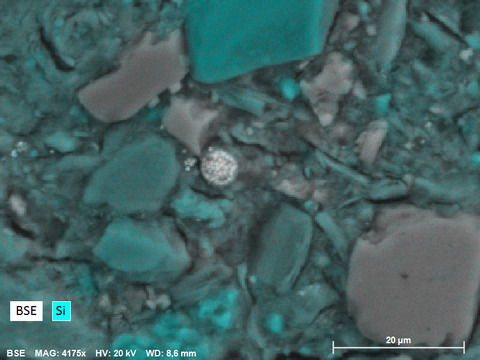
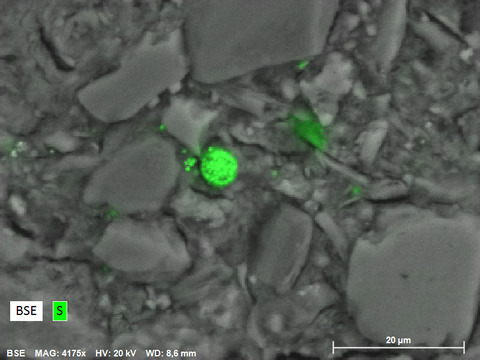
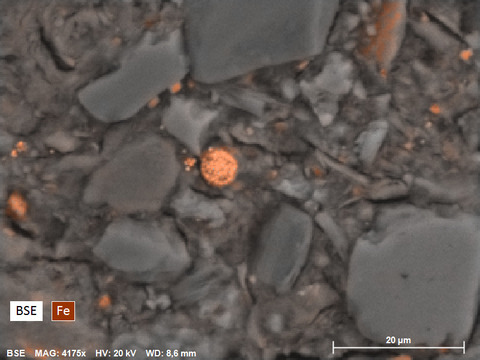
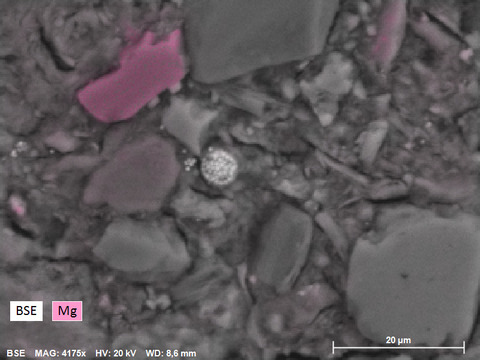
Color:
The ground has a dark reddish-brown color that can be observed through the cracks in the painting (tech. fig. 19).
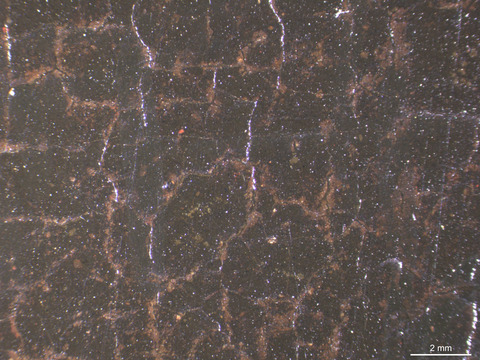
Application:
The ground is applied evenly across the whole canvas.
Thickness:
Moderate
Sizing:
Glue size (untested)
Character and Appearance (Does texture of support remain detectable / prominent?):
The highly textured canvas is visible in the final painting and appears to have been desired by Ribera; the ground was applied so as not to completely mask this texture. However, the pronounced texture of the canvas may have been enhanced by excessive heat and moisture during lining.
Condition of Ground
The ground in in generally good condition. There is a network of age cracks that is consistent with the age of the painting. There are significant losses to the ground along the edges of the canvas and associated with the tears and losses to the canvas (see Condition of Support). These losses have been filled and inpainted.
Description of Composition Planning
Methods of Analysis:
Surface observation (unaided or with magnification)
Infrared reflectography (IRR)
X-radiography
Analysis Parameters:
| X-radiography equipment | GE Inspection Technologies Type: ERESCO 200MFR 3.1, Tube S/N: MIR 201E 58-2812, EN 12543: 1.0mm, Filter: 0.8mm Be + 2mm Al |
|---|---|
| KV: | 25 |
| mA: | 3.0 |
| Exposure time (s) | 60 |
| Distance from Xray tube: | 36″ |
| IRR equipment and wavelength | Opus Instruments Osiris A1 infrared camera with InGaAs array detector operating at a wavelength of 0.9-1.7µm. |
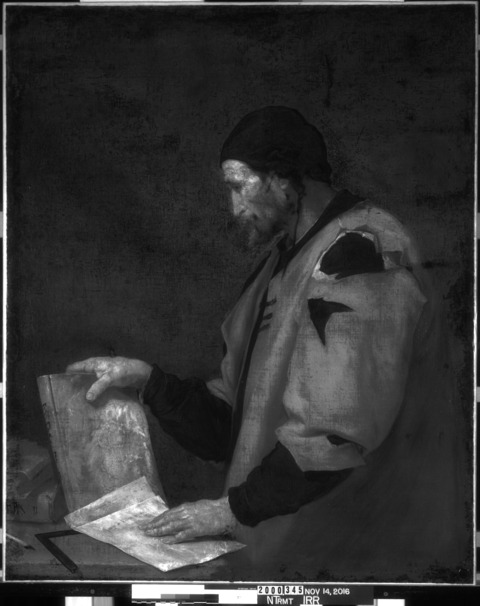
Medium/Technique:
The infrared absorbing ground makes it difficult to identify carbon-containing underdrawing using infrared reflectography. What is clear is that Ribera outlined elements of the composition in black paint. Many of the lines that are visible are applied over the paint layer as a final graphic element. However, it is likely that a similar contoured underpainting was used to establish the composition (tech. fig. 20).13
Pentimenti:
None apparent
Description of Paint:
Analyzed Observed
Application and Technique:
In the tradition of seventeenth-century Italian artists, Ribera painted on a dark red ground. He utilized the ground and textured canvas to efficiently achieve form and convey the contemplative nature of the moment (tech. fig. 21). The focus of the composition, the man’s concentrating face along with his books and papers, is emphasized by the masterful buildup of highlights using thick dabs of light-colored paint that contrast with the dark void behind the figure. The hands were painted with fluid, swirling dabs of paint with a small, textured brush. This loose, confident brushwork creates the appearance of worn, wrinkled skin (tech. fig. 22) with dabs of white paint to create glittering highlights on the fingernails (tech. figs. 23, 24).
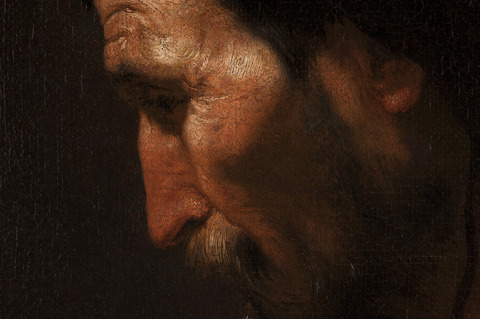
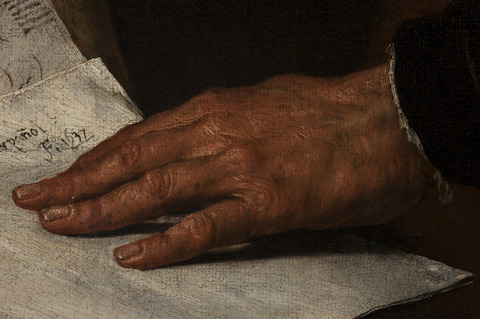
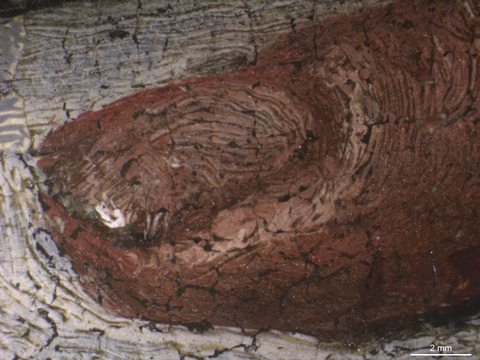
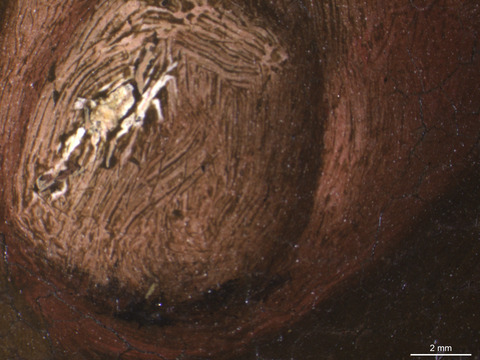
Ribera did not use the exposed ground as a midtone. Rather, he mixed and directly applied midtones, highlights, and shadows to create the illusion of form (tech. fig. 25). The ground does, however, create overall warmth that enhances the depths of the shadows. The ground is also visible through cracks in the black paint of the background, but it is unclear if this is intentional or a result of cleaning abrasion.
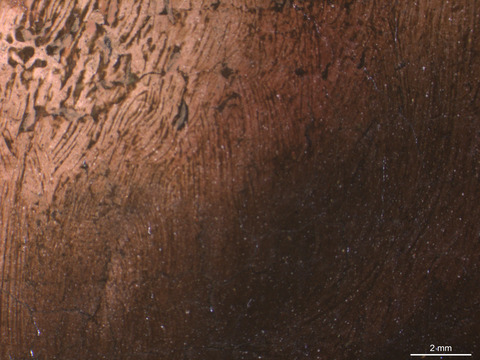
Ribera does not appear to have incorporated the use of glazes to create shadows. Rather he mixed and applied each variation of tone with a thick, direct application of paint (tech. fig. 26). This direct buildup of paint can be observed across the painting in the cross sections from different areas of the picture. The paint layer is consistently applied directly to the ground in a single layer.
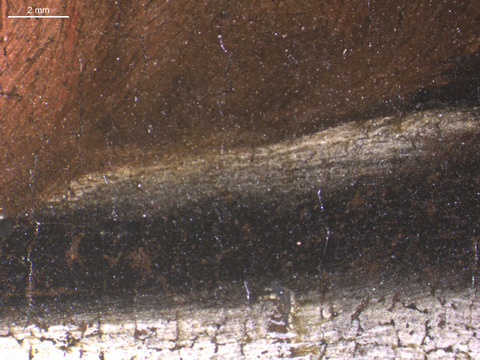
Over the established form, Ribera used painted outlines to create crisp edges and emphasize a graphic appearance (tech. fig. 27).
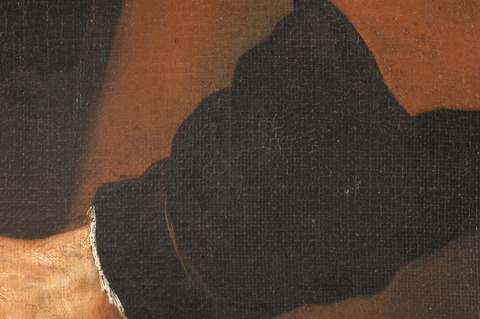
Painting Tools:
Medium/ large brushes with bristly texture
Binding Media:
Oil (untested)
Color Palette:
The palette is limited in color and composed of primarily iron oxide earth pigments (including umber), lead white, carbon black, calcium-containing white, and possibly red lead (tech. fig. 28; table 2).
XRF Analysis:
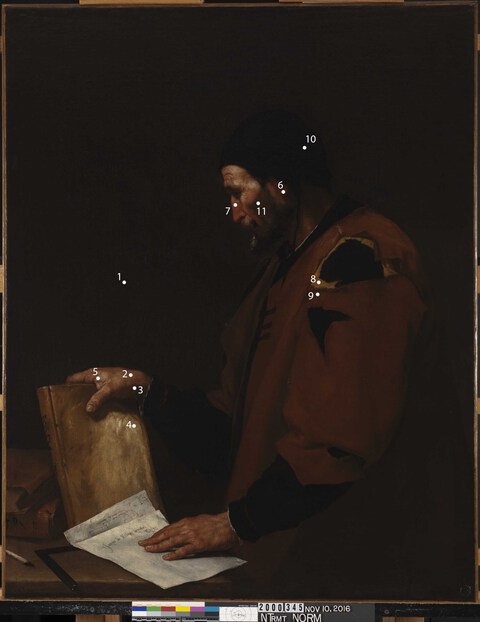
| Sample | Location | Elements | Possible Pigments |
|---|---|---|---|
| 1 | Background, ground layer (25 cm from left edge, 56 cm from top edge) | Major: Fe Minor: Pb, Ca Trace: K, Mn, Zn, Sr, Ti, Cu | Iron-oxide pigments (including umber), lead white, calcium-containing white, trace of titanium from iron-containing pigments (and or retouching), trace of zinc (likely from iron-containing pigments). |
| 2 | Hand midtone (27 cm from left edge, 47 cm from bottom edge) | Major: Pb Minor: Fe Trace: Mn, Ca | Lead white, possibly red lead, iron-oxide pigments, calcium-containing white. |
| 3 | Hand shadow (26.5cm from left edge, 44.5 cm from bottom edge) | Major: Pb, Fe Minor: Trace: Mn, Ca, Cu, Zn | Lead white, possibly red lead, iron-oxide pigments (including umber), calcium-containing white. |
| 4 | Yellow book (27cm from left edge, 36 cm from bottom edge) | Major: Pb Minor: Trace: Ca, Fe | Lead white, possibly red lead, iron-oxide pigments, trace of calcium-containing white. |
| 5 | Hand highlight (21 cm from left edge, 45 cm from bottom edge) | Major: Pb Minor: Trace: Fe, Ca | Lead white, possibly red lead, trace of iron-oxide pigments, calcium-containing white. |
| 6 | Earlobe (39.5 cm right left edge, 84 cm from bottom edge) | Major: Pb, Fe Minor: Trace: Mn, Ca, Zn | Lead white, possibly red lead, iron-oxide pigments (including umber), calcium-containing white. |
| 7 | Nose (48 cm from right edge, 42 cm from top edge) | Major: Pb Minor: Fe Trace: Ca, | Lead white, possibly red lead, trace of iron-oxide pigments, trace of calcium-containing white. |
| 8 | Yellow edging on cloak (29.5 cm from right edge, 66 cm from bottom edge) | Major: Pb Minor: Fe Trace: Ca, K, Mn, Cu | Lead white, possibly red lead, trace of iron-oxide pigments, trace of calcium-containing white. |
| 9 | Red cloak (29 cm from right edge, 62.5 cm from bottom edge) | Major: Fe, Pb Minor: Trace: Ca, Mn | Iron-oxide pigments (including umber), lead white, possibly red lead, calcium-containing white, trace of zinc (likely from iron-containing pigments). |
| 10 | Black cap (34 cm from right edge, 35 cm from top edge) | Major: Fe Minor: Pb, Ca Trace: Ti, Mn, Zn, Sr, Cu, K | Likely carbon black, iron-oxide pigments (including umber), lead white, possibly red lead, calcium-containing white, trace of titanium from iron-containing pigments (and or retouching), trace of zinc (likely from iron-containing pigments). |
| 11 | Shadow on face (44 cm from right edge, 38 cm from top edge) | Major: Fe Minor: Pb, Ca, Mn Trace: Cu | Likely carbon black, iron-oxide pigments (including umber), lead white, possibly red lead, calcium-containing white, trace of titanium from iron-containing pigments (and or retouching), trace of zinc (likely from iron-containing pigments). |
Table 2: Results of X-ray fluorescence analysis conducted with a Bruker Artax microfocus XRF with rhodium tube, silicon-drift detector, and polycapillary focusing lens (~100μm spot).
*Major, minor, trace quantities are based on XRF signal strength not quantitative analysis
Surface Appearance:
The texture of the open-weave canvas created a slightly textured surface across the paintings. This is exaggerated in the areas of highlight, including the figure’s skin and in the papers and books, where the paint has been built up into thicker layers with brushy application of slightly drier paint.
Condition of Paint
The paint layer is in fair condition. There is significant damage to the paint layer at the edges of the canvas where the tacking margins were removed before lining. There are also areas of loss throughout the picture plane, especially surrounding tears and losses to the support. The background has endured some cleaning abrasion, but the figure and books are in generally good condition.
Description of Varnish/Surface Coating
Analyzed Observed Documented
| Type of Varnish | Application |
|---|---|
| Natural resin | Spray applied |
| Synthetic resin/other | Brush applied |
| Multiple Layers observed | Undetermined |
| No coating detected |
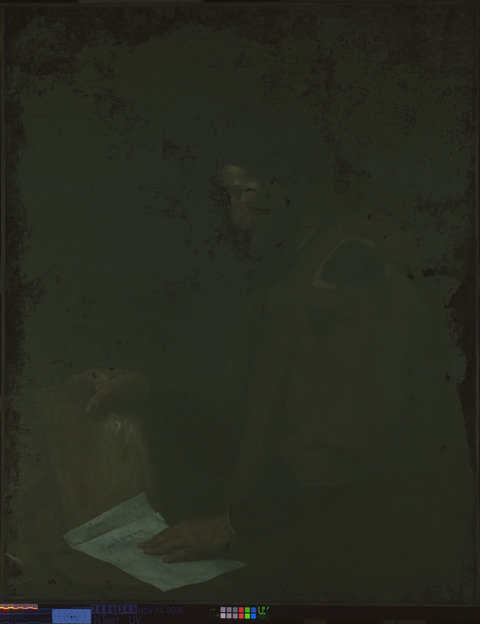
There are several layers of varnish on the painting. A thick layer of natural resin (untested) varnish is applied evenly across the surface and fluoresces yellowish green in ultraviolet-induced visible fluorescence (tech. fig. 29). This layer of varnish was likely applied by the restorer for the Liechtenstein Collection who cleaned the painting in the 1950s.14 At least one layer of synthetic varnish also appears to be present. This was likely applied during the 1991 treatment.
Several campaigns of inpainting are also apparent. One campaign appears dark in ultraviolet-induced visible fluorescence and is likely applied over the natural resin coating. This inpainting is especially extensive along the edges of the canvas and in the figure’s face. A second, likely older, campaign is identifiable in the infrared reflectogram. This campaign is especially apparent over the damages to the canvas and along the edges.
Condition of Varnish/Surface Coating
The varnish fluoresces strongly in ultraviolet-induced visible fluorescence. This layer is undoubtedly discolored, but the dark tone and strong contrasts in the painting mask the extent to which this impacts the appreciation of the work. Nuances in the darks of the picture are muddied by the murky, discolored varnish.
The inpainting is slightly discolored, especially along the extensive repaint covering the losses to the edges. From a viewing distance, this is not immediately noticeable.
Description of Frame
Original/first frame
Period frame
Authenticity cannot be determined at this time/ further art historical research necessary
Reproduction frame (fabricated in the style of)
Replica frame (copy of an existing period frame)
Modern frame
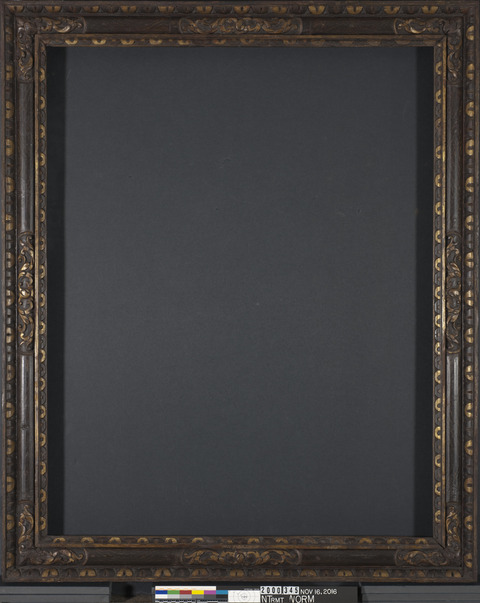
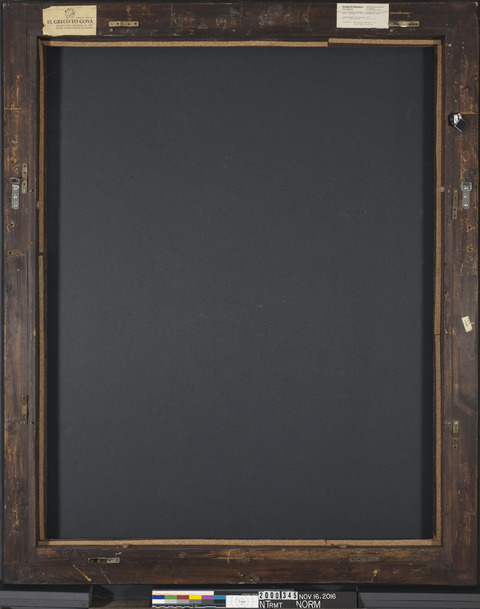
Frame Dimensions:
Outside dimensions: 146 × 119 × 7.5 cm
Sight dimensions 122.5 × 96 cm
Rebate dimensions: 125.5 × 100 cm
Distinguishing Marks:
Item 6. Paper label printed in black ink: “April 20-May 26/ EL GRECO TO GOYA/ Exhibition—museum of art/ Rhone Island School of Design,” left side of upper frame member (tech. fig. 31).
Item 7. Paper label printed in black ink: “Kimbell Art Museum/ Fort Worth/ 3333 Camp Bowie Boulevard/P.O. Box 9440/ Fort Worth, Texas 76107/ Exhibition: ‘Jusepe de Ribera—lo Spangnoletto (1591-1652)'/ Dates: December 4, 1982–February 6, 1983/ A Philosopher (Aristotle), 1637/ o/c 127 x 102 cms Cat. No. 18/ Collections: Indianapolis Museum of Art/ Clowes Fund Collections,” center of upper frame member (tech. fig. 31).
Item 8. Paper label on frame handwritten in brown ink: “T.R. 10066,” halfway down right frame member (tech. fig. 31).
Description of Molding/Profile:
The frame is of Venetian origin and was estimated by Timothy Newbery to be from about 1560,15 making it considerably older than the painting itself. Newbery describes the back of the frame as pine with a half-lapped joint construction. The front is carved walnut that has been parcel-gilt (tech. fig. 30). The convex friezes (tech. fig. 32) have a lotus leaf motif and the central panels have cauliculi radiating out from a husk motif at the center of each edge and corners.
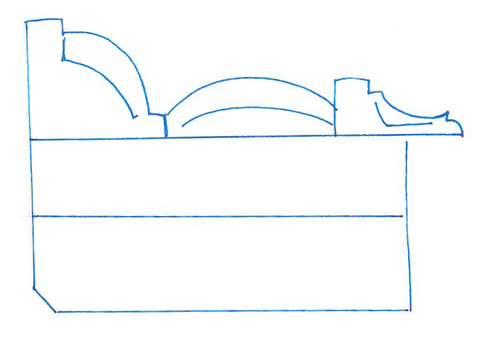
Condition of Frame
The frame is in generally good condition for its age. The sight line is slightly inhibited by warp at the ends of the panels.
Additional Notes or Comments
Glazing and build up on the back was added in 2019.
Notes
-
Letter from Bert Newhouse to G.H.A. Clowes, 13 December 1955, Correspondence Files, Clowes Registration Archive, Indianapolis Museum of Art at Newfields. ↩︎
-
Mark Roskill, “Clowes Collection Catalogue” (unpublished typed manuscript, IMA Clowes archive, Indianapolis Museum of Art, Indianapolis, IN, 1968). ↩︎
-
Paul A.J. Spheeris, “Conservation Report on the Condition of the Clowes Collection,” 25 October 1971, Conservation Department Files, Indianapolis Museum of Art at Newfields. ↩︎
-
Martin Radecki, Clowes Collection condition assessment, undated (after October 1971), Conservation Department Files, Indianapolis Museum of Art at Newfields. ↩︎
-
Memorandum from Martin Radecki to Bret Waller, “Conservation Work on Clowes Fund Collection,” 16 February 1996, Conservation Department Files, Indianapolis Museum of Art at Newfields. ↩︎
-
David Miller, “Treatment report (2000.345),” 30 April 1992. Conservation Department Files, Indianapolis Museum of Art at Newfields. ↩︎
-
“Treatment report (2000.345),” 14 April 2003. Conservation Department Files, Indianapolis Museum of Art at Newfields. ↩︎
-
Vincenzio Fanti, Descrizzione completa di tutto ciò che ritrovasi nella galleria di pittura e scultura di sua altezza Giuseppe Wenceslao del S.R.I., principe regnante della casa di Lichtenstein (Vienna: Stamperia di Giovanni Tommaso de Trattnern, 1767), 113, https://archive.org/details/descrizzionecomp00fant/page/n112/mode/1up. ↩︎
-
The current dimensions are: 124.1 × 98.4 cm. “Jusepe de Ribera, Protagoras (1957. 444),” Wadsworth Atheneum Museum of Art Collection Search. ↩︎
-
The current dimensions are: 124.3 × 99.06 cm. “Jusepe de Ribera, A Philosopher (M.91.125.2),” LACMA, https://collections.lacma.org/node/172070 ↩︎
-
The current dimensions of this painting are 125 cm × 81 cm, but it has been slightly reduced on the right side. “Jusepe de Ribera, Democritus ( P001121)” Museo del Prado Collection Search, https://www.museodelprado.es/en/the-collection/art-work/democritus/eb5f6aeb-ae96-40ff-a401-7dc415664189 ↩︎
-
David Goist, “Historical Review of Nails and Tacks” in AIC Wiki: PSG Stretchers and Strainers - III. Materials and Equipment (October 2004) Last modified 12 March 2014, illustration 43, http://www.conservation-wiki.com/wiki/PSG_Stretchers_and_Strainers_-_III._Materials_and_Equipment. ↩︎
-
For a discussion of Ribera’s underdrawing and technique more generally, see Rafael Romero and Adelina Illán, “Painting Techniques in the Work of Jusepe de Ribera: A Study Based on Development of the Artist’s Style,” Colnaghi Studies Journal 4 (March 2019): 62–81, https://www.paperturn-view.com/?pid=NDU45581&p=9&v=1.1. ↩︎
-
Letter from Bert Newhouse to G.H.A. Clowes, 13 December 1955, Correspondence Files, Clowes Registration Archive, Indianapolis Museum of Art at Newfields. ↩︎
-
Timothy Newbery, frame specialist, London, England. Visual analysis completed at the Indianapolis Museum of Art, 19 January 2012. ↩︎
Additional Images
